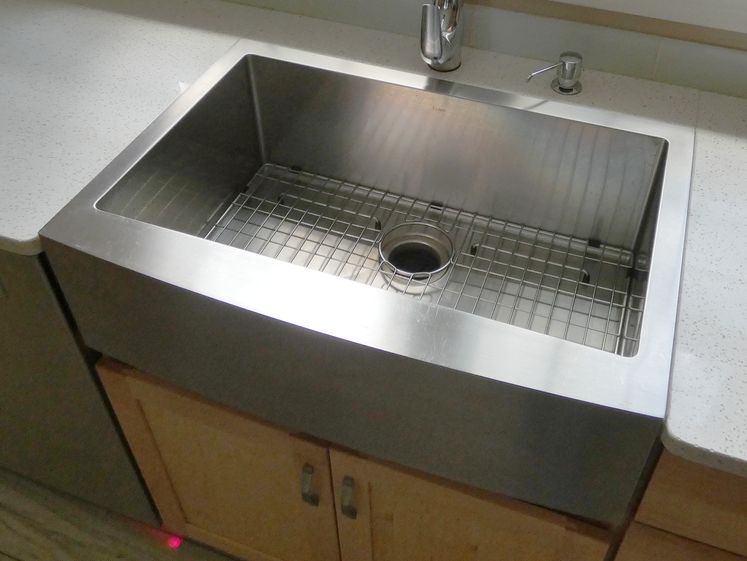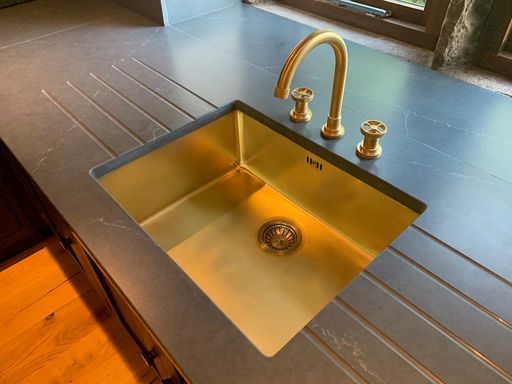Everybody wants an amazing sink. And it used to be that you had two choices: a flush mount or an undermount sink. Now there are more options, but these two styles are chosen by most people. Both of them have their advantages and disadvantages, which we’ll cover below.
- What Is a Flush Mount Sink?
- What Is an Undermount Sink?
- Differences Between Flush Mount Sink and Undermount Sink
What Is a Flush Mount Sink?
A flush-mount sink is a sink that sits flush with the countertop, which has a couple of inches around the bowl. The sink is usually recessed into the countertop and covered by a decorative piece of material, such as marble or granite. A flush mount sink can be installed in a variety of different ways. However, they are typically installed using clips that connect to the underside of the countertops.
Flush mount sinks are usually made of solid materials like ceramic or porcelain, although they can be made of other materials as well. Some people prefer to have their sinks made from natural stone materials like marble or granite because these materials are more durable than ceramic.

Flush Mount Sink Pros:
1. Easy to maintain and clean.
The design of flush mount sinks makes them easier to clean, but it also means that they don’t have a lot of crevices or grooves where bacteria can hide. This means that you need to clean them regularly and thoroughly.
2. Versatile installation.
A flush mount sink can be installed in any location you want because it’s not attached to a wall with plumbing fixtures like an undermount or pedestal sink. So flush mount sink installation is easier.
3. Saves on space underneath.
Flush mount sinks are great for small bathrooms because they don’t take up much space underneath. This means that you can install other things like cabinets or shelves under the sink without worrying about having enough room.
4. Appealing looks.
A flush mount sink has a sleek, modern look that’s perfect for small spaces where you don’t have much room to work with but still want a beautiful bathroom.
5. Sink flush countertop.
One important benefit of a flush mount sink is that it sits flush against the countertop. This means that there are no gaps between the two, which helps prevent water from leaking out of the sink and onto your countertop.
Flush Mount Sink Cons:
1. Expensive.
Flush mount sinks are usually more expensive than other sink styles.
2. Difficult installation.
Flush mount sinks can be difficult to install, especially if you’re not experienced with plumbing or electrical work.
3. Limited material options.
Flush mount sinks are usually made of porcelain or ceramic and don’t offer the same variety of material options as other sink styles.
What Is an Undermount Sink?
An under-mount sink is a type of sink that sits below the countertop. It’s called “undermount” because it doesn’t have a rim, or “lip,” that sticks up above the counter surface. The sink itself is flush with the countertop, which makes it easier to clean and more convenient for you to use.
Undermount sinks are also known as “drop-in” or “vessel” sinks, because they can be installed into any type of countertop. They have a wide range of styles and colors, so you can find one that fits your decor and matches your other accessories.
Undermount sinks are popular because they’re easier to clean than traditional drop-in sinks because there is less space between the bottom of your sink and your countertop surface; this means there’s less gap for dirt and grime to get trapped in.

Undermount Sink Pros:
1. Durable.
Undermount sinks are made of stronger materials than most other traditional sinks, which means they’re more durable and long-lasting.
2. Easy to clean.
Undermount sinks are easier to clean than other types of sinks because there’s less space between the bottom of your sink and your countertop surface. This means there’s less gap for dirt and grime to get trapped in.
3. Clean aesthetics.
Because undermount sinks are recessed into your countertop, they give your bathroom a clean, modern look. This is especially important if you have an older home and want to update its style without making too many changes at once.
4. Highly Versatile.
Undermount sinks can be installed in any kind of bathroom vanity or on a countertop from traditional wooden vanities to sleek modern ones. You can even install them in your cabinetry.
Undermount Sink Cons:
1. Hard to install.
Installing an undermount sink is a little more challenging than installing a drop-in or top-mount sink because it requires you to recess the countertop and create an opening for the sink.
2. More on the pricey side.
Undermount sinks can be a little more expensive than other types of sinks because they require extra work on your part.
3. More under vanity space taken up.
Installing an undermount sink can free up space on your countertop, but it’ll also take away from the limited cabinet real estate you have underneath because of its installation method.
Differences Between Flush Mount Sink and Undermount Sink
A comparison of the undermount sink and flush mount sinks’ pros and cons shows that they are quite similar. Although both types of sinks—flush mount and undermount—are easy to clean, difficult to install, and expensive, there are two key differences between them.
Installation
There are two main differences between a flush mount sink and an undermount sink. The first difference is that the former sits above your countertop, while the whole of the latter is installed underneath it. This means that if you have a large bathroom, an undermount sink will make it look even bigger because there is nothing else but flat surfaces surrounding it.
Space Efficiency
The second major difference is that they differ in their degree of space efficiency. Flush-mount sinks save more space below the countertop, while under-mount sinks have more space in the bowl.
Both styles of sinks have their advantages, but the choice will depend on the countertop material.
If you have something like a granite countertop, then you will want to use an under-mount sink because it will show off the natural beauty of the stone. If your counter is made from laminate or other types of man-made materials, then a flush-mount sink may be more appropriate since it has more space below for storing items such as cleaning supplies or linens.
In terms of aesthetics, there’s no right or wrong answer when choosing between undermount or flush mount sink—it’s all about personal preference.
Conclusion
Ultimately you’ll have to decide what’s best for your own situation. If you want a more seamless look, then an undermount sink may be better for you. If you have limited space and need to store things like cleaning supplies or linens below the sink, then a flush mount will probably work better.
The important thing is that no matter which type of sink you choose, it should be well made and durable so that it can last for many years without needing any repairs.
FAQ about Flush Mount vs Undermount Sink
No, they’re not the same thing. Flush mount sinks are installed on top of the countertop, while undermount sinks are installed underneath it.
The sink is fastened to the countertop with clips that hold it in place. These clips are designed to fit over the edge of your countertop, so they’ll be able to hold your sink in place no matter what kind of material your countertop is made out of.
Yes, undermount sinks can leak. But it’s important to know that this is usually only the case if you have a faulty drain, or if the seal between your sink and countertop isn’t tight.
0 Comments for “Flush Mount vs Undermount Sink: Know the Difference”